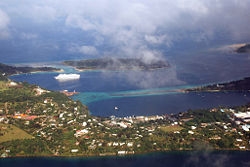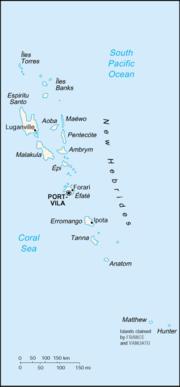|
|
|
|
|
|
|
|
|
|
|
|
Port VilaVanuatu - Melanesia - Pacific Ocean
Port Vila - Capital City
Port Vila is the capital city of Vanuatu. Aerial view of central Port Vila 
Map of Vanuatu Coordinates: 17°45'S 168°18'E / -17.75, 168.3 Country - Vanuatu Province - Shefa Province Population (1999) - Total 29,356 It is also Vanuatu's largest city. Situated on the south coast of the island of Efate, in Shefa Province, the city population at last census (1999) was 29,356,[1] an increase of 55% on the previous census result (1989). This suggests a 2007 population of about 40,000 or around 65% of the province's population. Port Vila is the economic and commercial centre of Vanuatu. History The area occupied by Port Vila has been inhabited by Melanesian people for thousands of years. In 1606, the first Europeans arrived at the island, led by Pedro Fernandez de Quirůs and Luis VŠez de Torres. In the 19th century, French settlers established the municipality of Franceville, which declared independence in 1889 and became the first self-governing nation to practice universal suffrage without distinction of sex or race. Although the population at the time consisted of about 500 native islanders and less than 50 whites, only the latter were permitted to hold office. One of the elected presidents was a U.S. citizen by birth, R.D. Polk. After 1887 the territory was jointly administered by the French and the British. This was formalized in 1906 as an Anglo-French Condominium. During World War II, Port Vila was an American and Australian airbase. In 1987, a cyclone severely damaged the city. Another powerful earthquake in January 2002 caused extensive damage in the capital and surrounding areas. Economy Port Vila is Vanuatu's most important harbour and the centre of the country's trade. The international airport, Bauerfield International is also located in the city. Major industries in the city remain agriculture and fishing. Tourism is also becoming important, especially from Australia and New Zealand. There were over 50,000 visitors in 1997. Vanuatu is a tax haven, and offshore financing in Port Vila is an important part of the economy. Vanuatu is still dependent on foreign aid, most of which comes from Australia and New Zealand although in recent years aid has also come from the Peoples Republic of China. Examples of Aid has been the New Zealand Government paying to train doctors selected from the local community and then paying part of their wages during the first year after qualification and Australia paying the wages of consultants to work in Port Vila Central Hospital. 35.7% of exports leave from Port Vila, whereas 86.9% of imports into the country arrived in Port Vila. Demographics The population of Port Vila is around 38,000. The population is predominately Melanesian, with small Polynesian, Asian and European populations, namely French and British. Language In Port Vila, Bislama is spoken by all the population as the day-to-day language. In addition, English and French are also widespread. Other Indigenous languages are also spoken in the city. Religion Christianity is the predominant religion across all of Vanuatu, followed by more than 90% of the population. The largest denomination is the Presbyterian Church, followed by one third of the population. Roman Catholicism and the Church of Melanesia are also common, each about 15%. Climate Port Vila has a tropical climate, with a Dry season and a hot, Wet season. Rainfall averages about 2,360 millimetres (94 in.) per year. The area also has South-East trade winds. Education Port Vila is one location of the University of the South Pacific, an educational institution co-owned by twelve Pacific countries. The Vanuatu campus is the only law school in the university, it also teaches language. Heritage Port Vila was the location in August 1999 for the important UNESCO meeting "2nd World Heritage Global Strategy Meeting for the Pacific Islands Region". One of the major topics with reference to Vanuatu and the Pacific region was the question of the suitability of underwater heritage for inscription on the World Heritage List.
All text is available under the terms of the GNU Free Documentation License (see Copyrights for details). About Wikipedia Disclaimers
2008
Site Index Back to Top Photos Index Thanks for coming, I hope you
have enjoyed it, will recommend
it to your friends, and will come
back later to see my site developing
and expanding.
|